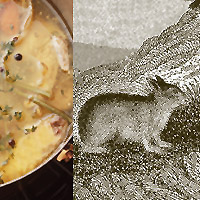Gluten Free
What does following a gluten-free diet mean? That you're embarking on an easy diet with a wide range of health-promoting effects. Instead of dwelling on what you’re giving up, consider that you’re going to enjoy a whole new world of delicious food options to meet your special dietary needs. You’ll be eating seasonally, choosing more fresh fruits and vegetables, focusing on meats, seafood, poultry, legumes, lentils, corn, and rice, and discovering fascinating ancient grains such as quinoa, amaranth, and millet. You’ll be able to eat potatoes, eggs, most cheeses, even chocolate (!)—and enjoy them without guilt because you’ll be taking good care of your body. In fact, you’ll probably end up eating—and feeling—better than ever!
Visit this page for more information about living Gluten Free
---
We carry a large variety of gluten free items, the brands listed below represent just some of the offerings we carry















More Diets
Rabbit

Preparation, Uses, & Tips
Rabbit can be substituted for chicken in many recipes.
Wash rabbit thoroughly in cold water and pat dry with paper towel. Rabbit should always be cooked until well done. For best results, use a meat thermometer inserted in the meatiest part of the rabbit. Internal temperatures should be as follows when the rabbit is done:
Breasts: 170°F (76.6°C)
Whole rabbit and other parts: 180°F (82.2°C)
To make a visual check to see if rabbit is done, pierce it with a fork. You should be able to insert the fork with ease, and the rabbit juices should run clear. Rabbit is thoroughly cooked when it is no longer pink inside.
To tenderize older rabbit or hare, place rabbit or hare in bowl. Pour 1 cup of vinegar over meat, then add enough vinegar to cover. Or marinate in a mixture of beer, garlic, and other spices. Cover and marinate in the refrigerator overnight.
Frying
In a plastic bag, mix together 1/2 cup (60g) flour, 1 teaspoon salt, and 1/4 teaspoon pepper. Add cut-up rabbit parts, a few at a time, and shake to coat. In a large frying pan, heat cooking oil to high temperature. Add rabbit and cook, uncovered, about 10 minutes, turning to brown all sides. Reduce heat to medium-low, cover, and cook until rabbit is brown and fork tender.
Braising
Dredge cut-up rabbit in flour and spices. Heat oil in a skillet over high heat, and brown rabbit pieces on each side. Add stock, spices, and vegetables if desired. Cover and bake in the oven at 325°F (160°C), or simmer over low heat on stovetop burner for 1 hour or until meat is fork tender.
Simmering
Place cut-up rabbit in a large pot or Dutch oven. Add water to cover (2 to 2 1/2 quarts or liters), 1 teaspoon salt, and 1/4 teaspoon pepper (1 small onion; sliced, 1 bay leaf, and 3 celery tops may also be added for richer broth flavor, if desired). Cover and simmer about 1 to 1 1/2 hours or until meat falls off bone. Remove rabbit from pan and cool. Separate meat from bones. Discard bones. Cut rabbit into desired size pieces.
Grilling
Rub rabbit parts with oil and spices. Place meat on prepared grill with rack about 8 inches (20cm) from heat source. Grill, turning frequently and basting with marinade until fork tender.
Microwaving
In a microwave-safe baking dish, arrange 1 cut-up rabbit in a single layer, with meatier parts toward the edge of the dish. Add broth, wine or water, spices, and vegetables. Cover and cook on High for 7 minutes, then on Low for 20 minutes, or until the rabbit is fork tender.
Copyright © 2025 TraceGains, Inc. All rights reserved.
Learn more about TraceGains, the company.
The information presented in the Food Guide is for informational purposes only and was created by a team of US–registered dietitians and food experts. Consult your doctor, practitioner, and/or pharmacist for any health problem and before using any supplements, making dietary changes, or before making any changes in prescribed medications. Information expires December 2025.











